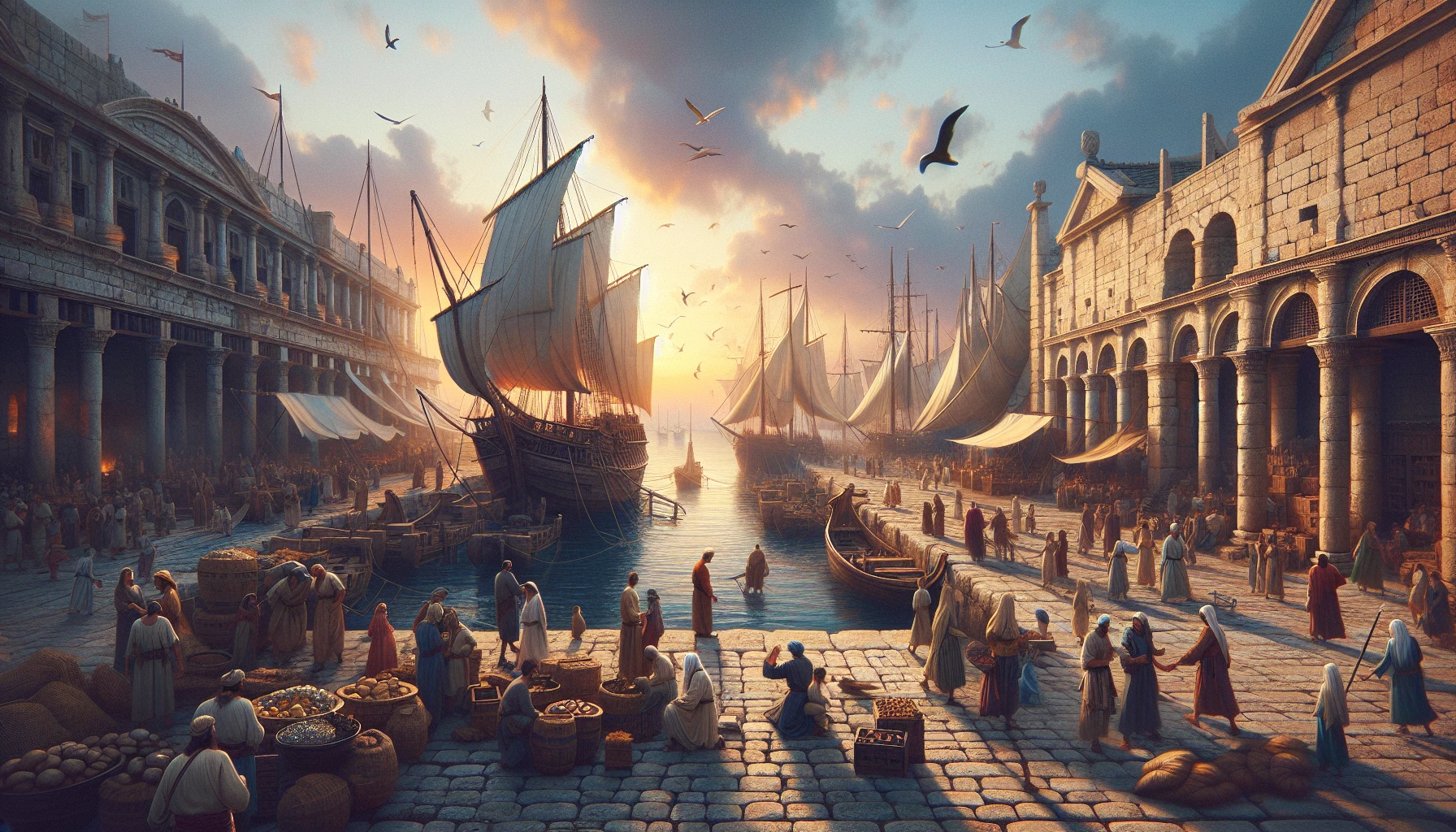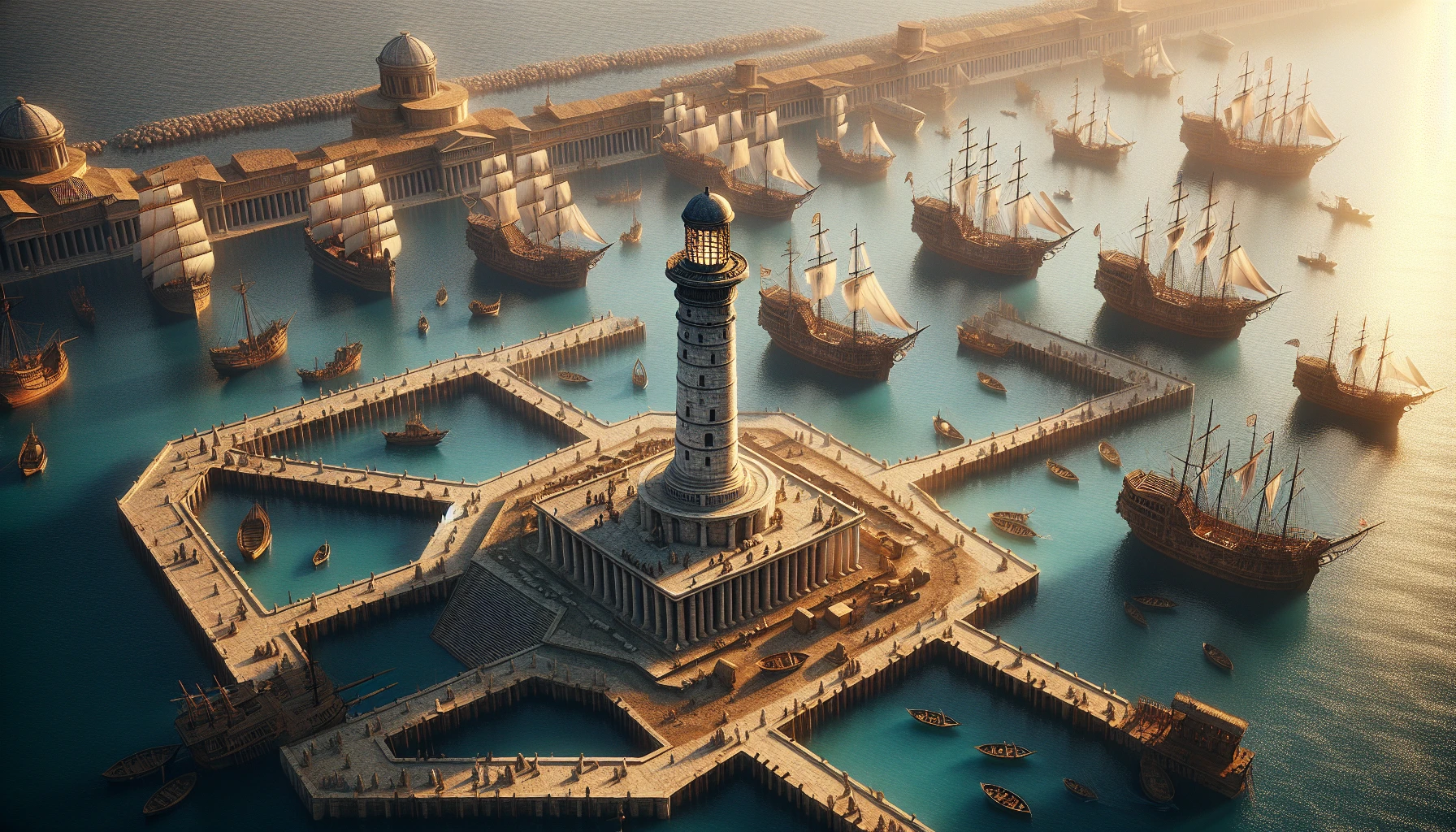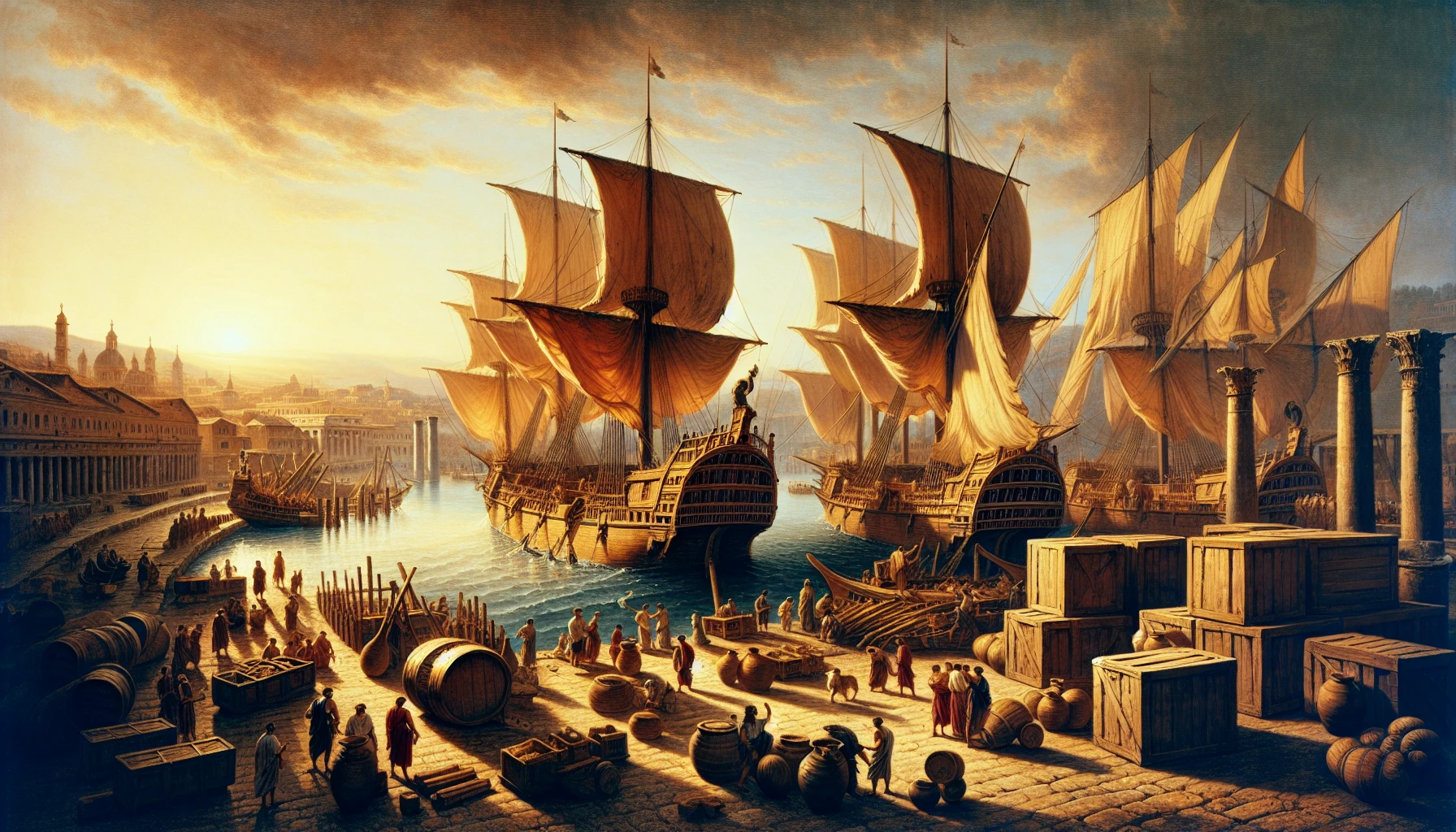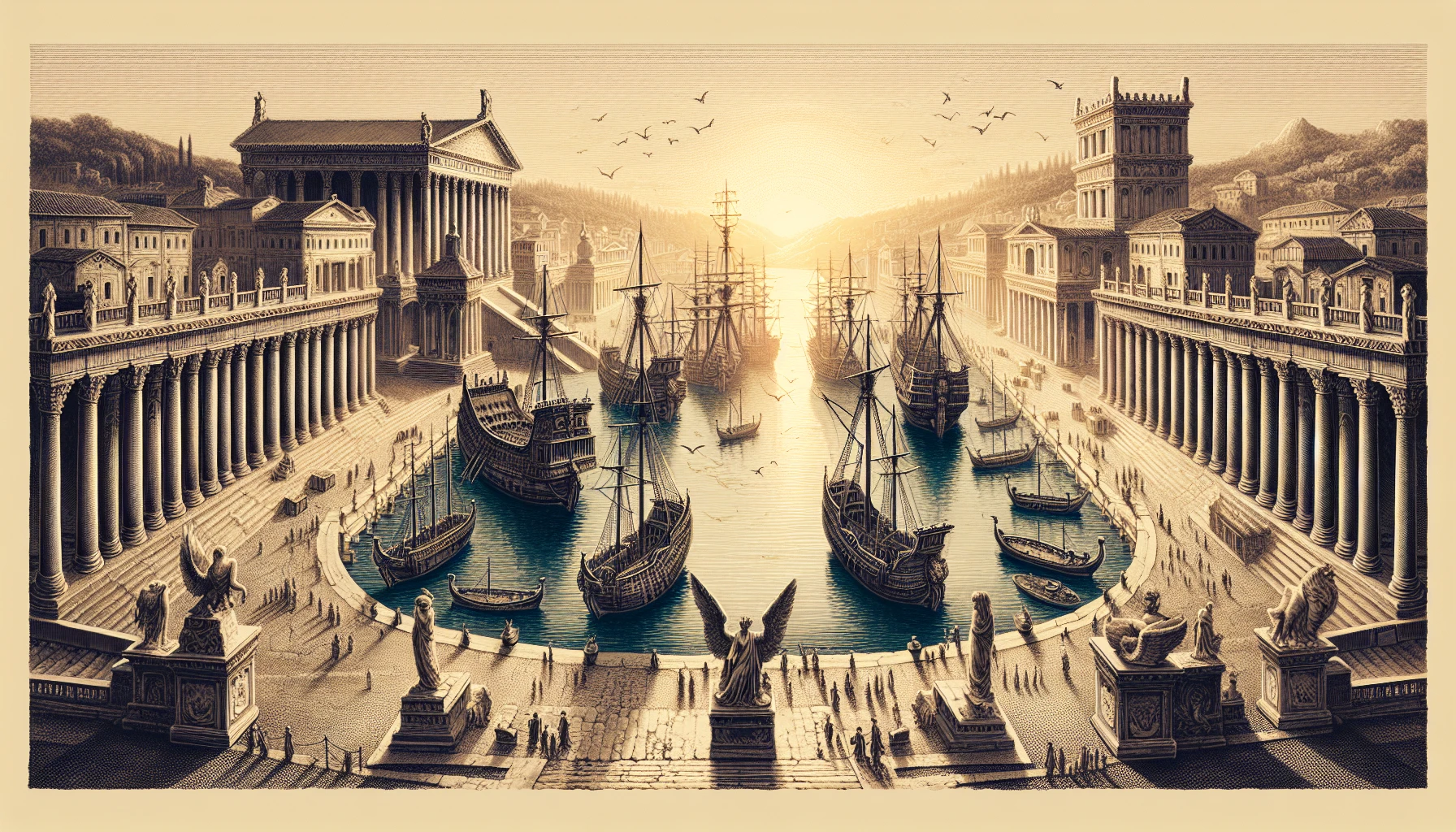Imagine standing in the heart of the Roman Empire where trade, commerce, and culture flourished, connecting the Mediterranean world to the great city of Rome. Welcome to Portus, Rome’s ancient port, a bustling harbor city that facilitated the flow of goods and people across the empire. Join us as we embark on a journey through time, uncovering the grandeur of Portus and its pivotal role in the history of ancient Rome.
Key Takeaways
- Emperors Claudius and Trajan created the vital harbor of Portus, “Portus Augusti”, to serve Rome’s maritime trade.
- Ancient Portus was a bustling harbor city with diverse inhabitants that contributed to Rome’s success.
- Excavations are uncovering the legacy of this architectural marvel, its role in Roman trade and economy, connections with Ostia Antica and Lazio region as well as historical depictions in art & cartography.
The Birth of Portus: Claudius and Trajan’s Vision

The construction of Portus began under Emperor Claudius and expanded by Emperor Trajan, creating a vital harbor for Rome’s maritime trade. Positioned near the River Tiber, the harbor was specifically designed to secure shelter from the frequent southwesterly winds, making it the main port of Rome. The harbor was bestowed the appellation “Portus Augusti” by Nero in honor of the imperial palace in Rome.
The harbor at Portus was safeguarded by two moles, with a breakwater in the fore, upon which the lighthouse stood. The entrance to the harbor was located on the north west side. Archaeological investigations by the British School at Rome revealed the unique hexagonal configuration of the harbor at Portus.
During the Trajanic phase of Portus, another harbor was constructed farther inland, encompassing an area of 39 hectares (97 acres) in the form of a hexagonal basin. The first basin, the outer harbor, was laid out approximately three kilometers north of the mouth of the Tiber, and a canal was excavated to the Tiber, with construction work progressing during the reign of Nero until the year AD 54.
The Harbour City: Life in Ancient Portus

Ancient Portus was a lively harbor city, brimming with activity and a varied population. Its residents engaged in various tasks such as trading, loading and unloading goods, managing port operations, and transporting goods. They were the lifeblood of this thriving harbor, which served as the gateway for imports like foodstuffs, wild animals from North Africa, marble, luxury goods, and slaves from across the Mediterranean and beyond.
Portus was established as a complement to Ancient Ostia, supporting the growing commerce needed to maintain the burgeoning city of Rome. As a result, Portus evolved into a city essential for Rome’s progression. It was equipped with facilities such as:
- Harbors
- Moles
- Warehouses
- Storage facilities
- Lighthouses
to support trade and commerce.
The primary occupations of the citizens residing in Ancient Portus, located on the north bank of the Tiber River, included tradesmen such as stone masons, blacksmiths, bricklayers, carpenters, and shopkeepers, as well as individuals in the armed forces. These residents enlivened the daily life of the harbor city and played a significant part in the prosperity of the Roman Empire.
Architectural Marvels: Key Structures and Features

The Romans were celebrated for their engineering skills, with Portus standing as a shining example. The imposing architectural structures of the harbor city showcased their remarkable skills in construction and design. One of the most notable features of Portus was its lighthouse, standing tall on the breakwater that safeguarded the harbor.
The unique hexagonal harbour structure was a testament to the architectural and engineering capabilities of the Romans. This geometric marvel was discovered during the archaeological investigations conducted by the British School at Rome, further emphasizing the grandeur and importance of the ancient port.
The Trajanic phase of Portus saw the construction of another harbor farther inland, consisting of a hexagonal basin encompassing an area of 39 hectares (97 acres). This expansion not only showcased the Romans’ ability to adapt and innovate but also solidified Portus’ status as the main port of Rome and a vital hub for trade and commerce.
Portus vs. Ostia Antica: Rivalry and Decline
Although Portus eventually overtook Ostia Antica as Rome’s primary port, both harbors faced decline due to the silting of the Tiber River and other factors. The competition between Portus and Ostia Antica was intensified by the strong currents at the river mouth and river silting, creating challenges for ships entering and exiting.
Ostia Antica was once the port of Rome and held a revered place in ancient sources as the landing site of Aeneas. However, the decline of both Portus and Ostia Antica was attributed to the silting of the Tiber River and other factors, ultimately leading to a shift in the primary port on the Tyrrhenian Sea prior to the 6th century AD.
Despite their competition and subsequent decline, both Portus and Ostia Antica had significant roles in Rome’s history and the Roman Empire. The strategic locations of these harbors, their architectural marvels, and their significance in trade and commerce leave an indelible mark on the annals of history.
The Legacy of Portus: Modern-Day Discoveries and Excavations
In recent years, modern archaeological excavations and discoveries have continued to shed light on the history and significance of Portus in the Roman Empire. The Portus Project, led by Simon Keay of the University of Southampton, is an ambitious endeavor exploring the magnificence of the port, its association with Rome, and its unparalleled role as the focal point of Rome’s Mediterranean port system.
The Portus Project is examining:
- The inception of Portus in the first century A.D.
- Its progression into the principal port of Rome
- The intricate dynamics of the port’s association with the city and the wider Roman Mediterranean
These contemporary discoveries and excavations offer a deeper understanding of Portus’ history, its architectural wonders, and its influence on the Roman world.
Today, the remains of Portus are incorporated administratively into the municipality of Fiumicino and are accessible to the public during specified days and times. Through these ongoing excavations and research, the legacy of Portus continues to be unveiled, offering a glimpse into the grandeur of Rome’s ancient port and its pivotal role in the Roman Empire.
Trade and Economy: Goods Flowing Through Portus

As a significant trade center, Portus managed the movement of goods like grain, wine, and luxury items between Rome and the rest of the Mediterranean world. The canal discovered in Portus in 2010 was utilized for approximately 400 years, from the late second century AD to the fifth and sixth centuries, to transport goods from various regions of the Empire to Rome.
Portus played a paramount role in the Roman economy as the principal port of ancient Rome for more than five centuries. The importation, storage, and circulation of commodities such as:
- glass
- ceramics
- marble
- slaves
- wild animals
were facilitated through the port, ensuring Rome’s stability and prosperity.
Trade in ancient Portus was facilitated through its strategic location at the mouth of the Tiber River and the intersection of significant trade routes, allowing for the exchange of goods from various areas. The sheltered natural basin in Portus provided a secure harbor for ships, further aiding trade. Traders from different origins would come to Portus to engage in commerce and often established corporations or associations to facilitate their operations.
The Lazio Region: Surroundings and Connections
The Lazio region, which includes Rome and its surrounding areas, played an important role in Portus’ development and operation as a significant port. The geographical features of the Lazio region include the presence of the central Apennines mountain ranges in the east, the Tiber River, and its proximity to the Mediterranean coast.
The vicinity of Rome to Portus was of great significance in the development and reputation of the port. The close proximity enabled convenient transportation of goods and materials between the two locations, thereby promoting trade and commerce. This vicinity also made Portus a strategic location for the import and export of goods, resulting in its economic importance and reputation in the region.
The physical geography of the Lazio region, featuring advantageous channel conditions and open-water conditions, enabled navigation and transportation of goods with larger vessels, thereby contributing to the trading capabilities of Portus. Furthermore, the port’s connection to the city of Ostia Antica further demonstrates the influence and interconnectivity of the Lazio region in the functioning of Portus.
Portus in Art and Cartography: Depictions Throughout History

Over the course of history, Portus has been represented in diverse forms of art and cartography, mirroring its significance and splendor in the Roman Empire. The earliest known artistic depictions of Portus include a 16th-century fresco illustrating Portus in Ostia Antica.
Roman artists depicted the city of Portus in their work through various mediums such as frescoes and illustrations. These depictions often highlighted the grandeur and architectural features of the ancient port, including its expansive artificial harbor and notable structures like the lighthouse.
Ancient Roman maps provide valuable details regarding Portus’ location and its role in the port system of the Roman Mediterranean. As a testament to its significance, artistic and cartographic depictions of Portus throughout history continue to offer a window into the grandeur and importance of Rome’s ancient port.
Summary
In conclusion, Portus stands as a testament to the engineering prowess and grandeur of the Roman Empire. Its strategic location, architectural marvels, and pivotal role in trade and commerce have left an indelible mark on history. As we continue to uncover the mysteries of this ancient port through modern-day discoveries and excavations, we gain a deeper understanding of the importance of Portus in the Roman world and its enduring legacy.
Frequently Asked Questions
What is the meaning of Portus?
Portus is a Latin word meaning ‘harbor’ or ‘port’, which was used to refer to the quays constructed along the Tiber River in Rome during the 2nd century BCE. It was used as a base for merchant, military and other ships, as well as warehouses and granaries.
Can you visit Portus?
Yes, you can visit Portus! The visit takes around 1 hour and is done riding a horse-car while accompanied by well-prepared guides from Legambiente.
Why was Portus important?
Portus was a large artificial harbour established by Claudius and enlarged by Trajan to supplement the nearby port of Ostia. It served as the Roman Empire’s leading maritime hub for nearly 500 years, making it one of their greatest engineering achievements.
Who had the vision for the construction of Portus?
Emperor Claudius and Emperor Trajan were credited with having the vision for the construction of Portus.
What was the primary function of Portus in the Roman Empire?
Portus was the main port of Rome, enabling trade and commerce throughout the Roman Empire.
